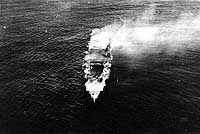
While their aviators flew back from Midway, the Japanese carriers received several counterstrikes from Midway's own planes. Faced with overwhelming fighter opposition, these uncoordinated efforts suffered severe losses and hit nothing but sea water. Shortly after 0700, torpedo attacks were made by six Navy TBF-1s and four Army Air Force B-26s. Between 0755 and 0820, two groups of Marine Corps bombers and a formation of Army B-17s came in. The only positive results were photographs of three Japanese carriers taken by the high-flying B-17s, the sole surviving photos of the day's attacks on the Japanese carriers.
Meanwhile, a tardy Japanese scout plane had spotted the U.S. fleet and, just as Midway's counterattacks were ending, reported the presence of a carrier. Japanese commander Vice Admiral Chuichi Nagumo had begun rearming his second group of planes for another strike on Midway. He now had to reload the aircraft with anti-ship weapons, recover the planes returning from Midway and reorganize his flight decks to launch an attack on the U.S. ships. Nagumo's force barely missed having enough time.
In the hour after about 0930, U.S. Navy planes from the carriers Hornet, Enterprise and Yorktown made a series of attacks, initially by three squadrons of TBD torpedo planes that, despite nearly total losses, made no hits. The sacrifice of the TBDs did slow Japanese preparations for their own strike and disorganized the defending fighters. Then, at about 1025, everything changed. Three squadrons of SBD scout bombers, two from Enterprise and one from Yorktown, almost simultaneously dove on three of the four Japanese carriers, whose decks were crowded with fully armed and fueled planes that were just starting to take off. In a few minutes, Akagi, Kaga and Soryu were ablaze and out of action.
Of the once-overwhelming Japanese carrier force, only Hiryu remained operational. A few hours later, her planes crippled USS Yorktown. By the end of the day, though, U.S. carrier planes found and bombed Hiryu. Deprived of useful air cover, and after several hours of shocked indecision, Combined Fleet commander Admiral Isoroku Yamamoto called off the Midway operation and retreated. Six months after it began, Japan's great Pacific War offensive was over.
This page provides an overview of U.S. attacks on the Japanese
carrier force. For images of these attacks, see:
For links to views of other aspects of the Battle of Midway,
see:
For artworks of attacks on the Japanese aircraft carriers, see the Navy Art Gallery presentation The Battle of Midway.
For further information and links to related resources, see Frequently Asked Questions: Battle of Midway, 4-7 June 1942.
NOTES:
Page made 11 April 1999
Text revised and coding updated 24 April 2009